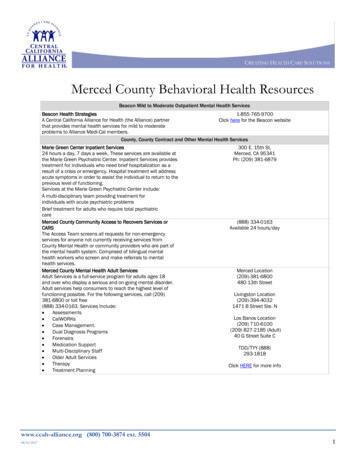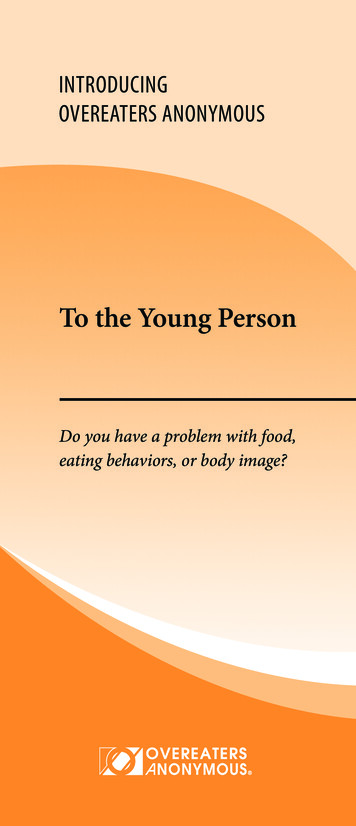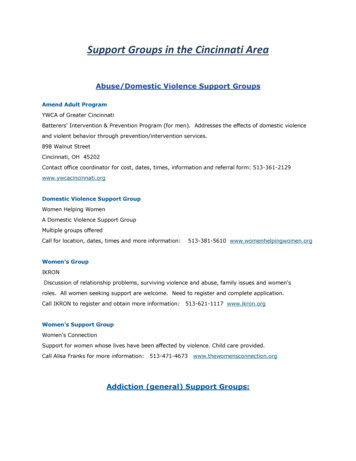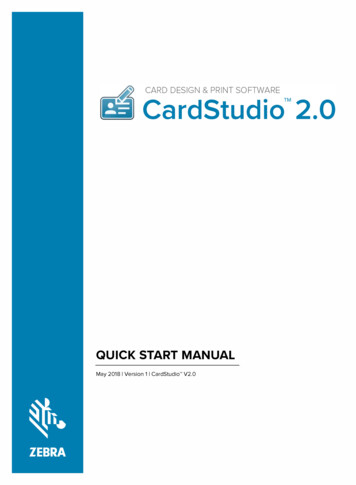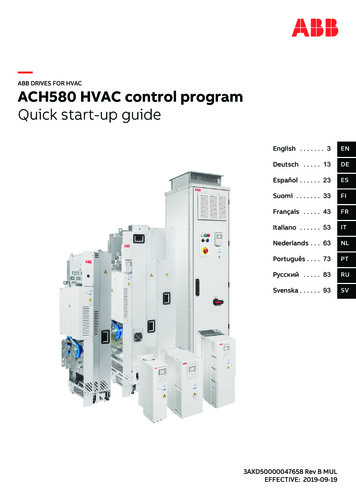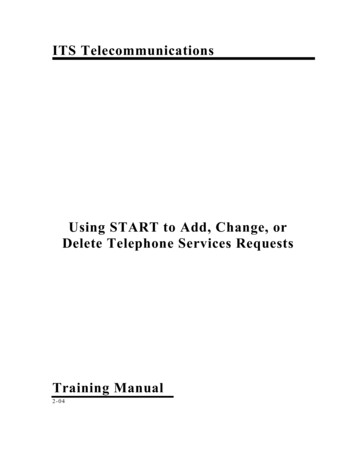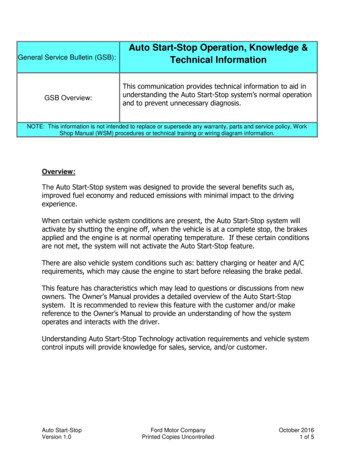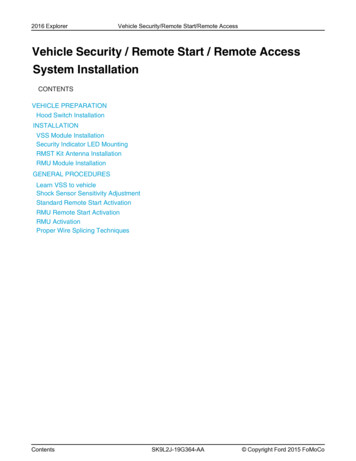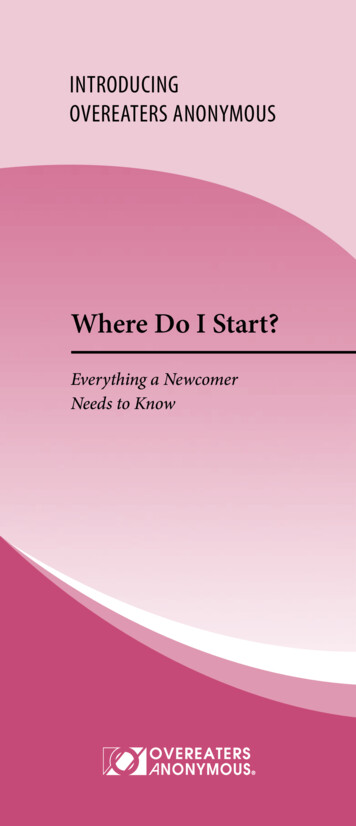
Transcription
INTRODUCINGOVEREATERS ANONYMOUSWhere Do I Start?Everything a NewcomerNeeds to Know1
Welcome, Newcomers!The brief excerpts from the Big Book, AlcoholicsAnonymous, Fourth Edition, are reprinted withpermission of Alcoholics Anonymous WorldServices, Inc. (“AAWS”). Permission to reprintthese excerpts does not mean that AAWS hasreviewed or approved the contents of this publication, or that AAWS necessarily agrees withthe views expressed herein. A.A. is a programof recovery from alcoholism only—use of theseexcerpts in connection with programs andactivities that are patterned after A.A., but that address other problems, or in any other non-A.A.context, does not imply otherwise.
THE TWELVE STEPS OFOVEREATERS ANONYMOUS1. We admitted we were powerless overfood—that our lives had becomeunmanageable.2. Came to believe that a Power greaterthan ourselves could restore us to sanity.3. Made a decision to turn our will andour lives over to the care of God as weunderstood Him.4. Made a searching and fearless moralinventory of ourselves.5. Admitted to God, to ourselves and toanother human being the exact natureof our wrongs.6. Were entirely ready to have God removeall these defects of character.7. Humbly asked Him to remove ourshortcomings.8. Made a list of all persons we hadharmed, and became willing to makeamends to them all.9. Made direct amends to such peoplewherever possible, except when to do sowould injure them or others.10. Continued to take personal inventoryand when we were wrong, promptlyadmitted it.11. Sought through prayer and meditationto improve our conscious contact withGod as we understood Him, prayingonly for knowledge of His will for usand the power to carry that out.12. Having had a spiritual awakening as theresult of these Steps, we tried to carrythis message to compulsive overeatersand to practice these principles in allour affairs.Permission to use the Twelve Steps of Alcoholics Anonymous foradaptation granted by AA World Services, Inc.
Dear Newcomer,Welcome to Overeaters Anonymous. OA is aFellowship of individuals who, through shared experience, strength, and hope, are recovering fromcompulsive eating and compulsive food behaviorsby working the Twelve Steps.If you have tried to achieve a healthy bodyweight through many methods, only to fail repeatedly, or if your inability to control your eating isbeginning to frighten you, then please consider attending an OA meeting. To find a meeting, go tooa.org and click on Find a Meeting.At OA meetings, you will find others who havethe same concerns and who share your feelings.Chances are you will find many of the answers youneed. Overeaters Anonymous is a simple programthat works. There are no dues or fees. We are selfsupporting through our own contributions. Theonly requirement for membership is a desire tostop eating compulsively.Now that you have found Overeaters Anonymous, you may want to make sure our programis right for you. Many of us have found it useful toanswer the following questions to help determineif we have a problem with compulsive eating.1. Do I eat when I’m not hungry, or not eatwhen my body needs nourishment?2. Do I go on eating binges for no apparentreason, sometimes eating until I’m stuffedor even feel sick?3. Do I have feelings of guilt, shame, or embarrassment about my weight or the way I eat?4. Do I eat sensibly in front of others and thenmake up for it when I am alone?5. Is my eating affecting my health or the wayI live my life?6. When my emotions are intense—whetherpositive or negative—do I find myselfreaching for food?7. Do my eating behaviors make me or othersunhappy?1
8. Have I ever used laxatives, vomiting,diuretics, excessive exercise, diet pills,shots, or other medical interventions(including surgery) to try to control myweight?9. Do I fast or severely restrict my food intaketo control my weight?10. Do I fantasize about how much better lifewould be if I were a different size or weight?11. Do I need to chew or have something inmy mouth all the time: food, gum, mints,candies, or beverages?12. Have I ever eaten food that is burned,frozen, or spoiled; from containers in thegrocery store; or out of the garbage?13. Are there certain foods I can’t stop eatingafter having the first bite?14. Have I lost weight with a diet or “periodof control” only to be followed by bouts ofuncontrolled eating and/or weight gain?15. Do I spend too much time thinking aboutfood, arguing with myself about whetheror what to eat, planning the next diet orexercise cure, or counting calories?Have you answered “yes” to several of thesequestions? If so, it is possible that you have, or arewell on your way to having, a compulsive eating orovereating problem.As a newcomer to Overeaters Anonymous, youprobably have many questions about this programof recovery. What makes OA different from otherprograms? How can OA help you recover fromcompulsive eating and maintain a healthy weightwhen everything else you’ve tried has failed? CanOA help you stop bingeing or yo-yo dieting? Howcan you achieve freedom from food obsession andcompulsive eating? Is there any hope?You Are Not AloneYou are no longer alone. We, too, have experienced hopelessness when we tried to control ourproblems with food or eating. We have tried every diet and used many methods to control our2
body size, without success. We could not enjoylife because of our obsession with food, weight,and/or size. We could not stop eating too mucheven when we really wanted to. At times, some ofus even refused to eat because we were afraid wewould be overcome by our appetite. We felt shameand humiliation about our behavior with food.We are not like normal people when it comesto eating. What all of us have in common is thatour bodies and minds send us signals about foodwhich seem to be quite different from those thenormal eater receives. Many of us can’t stop oncewe start eating, and even if we have managed tostop from time to time, we can’t keep from startingagain. Some of us have repeatedly tried and failedto control other compulsive eating behaviors. Sothe cycle continues.In Overeaters Anonymous, we learned that wehave an illness, an unhealthy condition of bodyand mind that can be relieved on a daily basis. OAoffers a solution. We find that we no longer want toreturn to the foods and eating behaviors that created uncontrollable cravings. We have been releasedfrom our mental obsession. We are able to achieveand maintain a healthy body weight. For us, that isnothing less than a miracle. We have found a wayto abstain from our compulsive behaviors relatedto food, diets, weight, exercise, and/or body image.We realized that we could not recover by ourselves, so we learned to share with other OA members. Instead of reaching for food to soothe ournerves, we went to a meeting, wrote about ourfeelings, read some OA literature, or called oursponsor. As we practiced these new and healthybehaviors, we began to feel safe. We found a homein the Fellowship and the support that OA offersus. We discovered that we can recover by following OA’s Twelve Steps and by reaching out to helpothers with the same problem.We promise that if you work the Twelve Steps tothe best of your ability, regularly attend meetings,and use OA’s Tools, your life will change. You willexperience what we have: the miracle of recoveryfrom compulsive eating.3
Many Symptoms, One SolutionIn Overeaters Anonymous, you’ll find memberswho are: Extremely overweight, even morbidlyobese Only moderately overweight Average weight Underweight Still maintaining periodic control overtheir eating behavior Totally unable to control their compulsiveeatingOA members experience many different patterns of food behaviors. These “symptoms” are asvaried as our membership. Among them are: Obsession with body weight, size, andshape Eating binges Grazing Preoccupation with reducing diets Starving Excessive exercise Inducing vomiting after eating Inappropriate and/or excessive use ofdiuretics and laxatives Chewing and spitting out food Use of diet pills, shots, and other medicalinterventions, including surgery, to controlweight Inability to stop eating certain foods aftertaking the first bite Fantasies about food Vulnerability to quick-weight-loss schemes Constant preoccupation with food Using food as a reward or for comfortOur symptoms may vary, but we share a common bond: We are powerless over food and ourlives are unmanageable. This common problemhas led those in OA to seek and find a commonsolution in the Twelve Steps and Twelve Traditionsof Overeaters Anonymous. We find that, no matter4
what our symptoms, we all suffer from the samedisease—one that can be arrested by living thisprogram one day at a time.Abstinence—Our Primary PurposeOA accepts the following: “Abstinence is theaction of refraining from compulsive eating andcompulsive food behaviors while working towards or maintaining a healthy body weight.Spiritual, emotional, and physical recovery is theresult of living and working the Overeaters Anonymous Twelve Step program on a daily basis.”Many of us have found we cannot abstain fromcompulsive eating unless we use some or all ofOA’s nine Tools of Recovery to help us practice theTwelve Steps and Twelve Traditions.The Tools of RecoveryAs we work the Overeaters Anonymous TwelveStep program of recovery from compulsive eating, we have a number of Tools to assist us. We usethese Tools—a plan of eating, sponsorship, meetings, telephone, writing, literature, action plan,anonymity, and service—on a regular basis, to helpus achieve and maintain abstinence and recoveryfrom our disease.A Plan of EatingAs a Tool, a plan of eating helps us abstainfrom compulsive eating, guides us in our dietarydecisions, and defines what, when, how, where,and why we eat. (See the pamphlet A New Plan ofEating for more information.) This Tool helps usdeal with the physical aspects of our disease andachieve physical recovery.SponsorshipWe ask a sponsor to help us through all threelevels of our program of recovery: physical, emotional, and spiritual. Find a sponsor who has whatyou want and ask that person how they are achieving it.5
MeetingsMeetings give us an opportunity to identify ourcommon problem, confirm our common solution,and share the gifts we receive through this TwelveStep program. In addition to face-to-face meetings, OA offers telephone and other types of virtual meetings that are useful in breaking throughthe deadly isolation caused by distance, illness, orphysical challenges.TelephoneMany members call, text, or email their sponsors and other OA members daily. Telephone orelectronic contact also provides an immediateoutlet for those hard-to-handle highs and lows wemay experience.WritingPutting our thoughts and feelings down on paper, or describing a troubling or joyous incident,helps us better understand our actions and reactions in a way that is often not revealed by simplythinking or talking about them.LiteratureWe read OA-approved literature, which includes numerous books, study guides, pamphlets,wallet cards, and selected Alcoholics Anonymoustexts. All this material provides insight into ourdisease and the experience, strength, and hopethat there is a solution for us.Action PlanCreating an action plan is the process of identifying and implementing attainable actions tosupport our individual abstinence and emotional,spiritual, and physical recovery. This Tool, like ourplan of eating, may vary widely among membersand may need to be adjusted as we progress in ourrecovery.AnonymityAnonymity is the spiritual foundation of all our6
Traditions, ever reminding us to place principlesbefore personalities (Tradition Twelve). Anonymity assures us that only we, as individual OAmembers, have the right to make our membershipknown to others. Anonymity at the level of press,radio, films, television, and other public media ofcommunication means that we never allow ourfaces or last names to be used once we identifyourselves as OA members (Tradition Eleven).Within the Fellowship, anonymity means thatwhatever we share with another OA member willbe respected and kept confidential. What we hearat meetings should remain there.ServiceAny form of service—no matter how small—that helps reach a fellow sufferer adds to the quality of our own recovery. Members who are new toOA can give service by attending meetings, sharing, and putting away chairs. All members can alsogive service by putting out literature, welcomingnewcomers, hosting a virtual meeting, or doingwhatever is needed to help the group. Memberswho meet specified requirements can give service beyond the group level by serving at the intergroup, service board, region, or world servicelevel.As OA’s Responsibility Pledge states: “Always toextend the hand and heart of OA to all who sharemy compulsion; for this I am responsible.”Further Information: a Plan of EatingMany of us came to Overeaters Anonymousexpecting to find the perfect diet and get ourfood problem under control. What we found instead was a Twelve Step program that provides afoundation for living a balanced and healthy life.We learned that OA does not have a specific diet.We came to understand that the basis for stopping our compulsive food behaviors—and stayingstopped—is personal, inner change. Yes, we had todecide—with help—the appropriate plan of eating for ourselves, but the power to follow that plancomes from emotional and spiritual change. We7
achieve this inner change by working the TwelveSteps and learning to live according to the Principles underlying the Steps. As a result of workingthe Twelve Steps, our obsession with food is lifted.Defining a New Way of Eating Is ImportantObviously, there is something wrong with ourcurrent eating patterns, or we would not havecome to OA. We are not like normal eaters. Generally, normal eaters eat appropriate amounts offood when they are hungry and stop eating whenthey are full. Normal eaters do not hide food orplan how they will secretly get it when no one isaround. They do not use food (or restrict it) in anattempt to control their unmanageable lives. Theydo not consistently use food to comfort their insecurities and fears or provide a fleeting escape fromtheir worries and troubles. Normal eaters usuallydo not feel guilt and/or shame about their eating.In OA, we discover that our problem is notlack of willpower. We have a disease. Where foodis concerned, we cannot trust our best intentionsor willpower to guide us in making good eatingdecisions. We have made hundreds of resolutionsto ourselves and others. We have tried many diets,therapies, hypnosis, and shots and pills. But wecould not stop our compulsive eating behaviors.Developing a Plan of EatingDeveloping a healthy plan of eating is our firsttask. While no plan of eating will be successfulwithout diligent Step work, using a plan of eatingas a Tool allows us to deal with food in a calm, rational, and balanced way. This is the beginning oflearning to eat according to our physical requirements rather than our emotional cravings.Reviewing Our Eating PatternsAs we individualize our plan of eating, we review eating patterns in order to learn which foodsand/or eating behaviors create cravings. Discussing our eating history with a sponsor and healthcare professional gives us objectivity and insight.When we seek help in developing a plan of eating,8
we practice the willingness to review our behaviors in a way we would not be able to do on ourown. We have learned that a suggestion made by asponsor or health care professional should not beautomatically rejected just because it makes us feeluncomfortable.As we reach a healthy body weight or as ourbodies change, we sometimes need to modify ourchoices. We might consider whether we need tochange the portions or the kinds of foods we eat.No matter what our body size, age, or gender, inaddition to refraining from compulsive eating behaviors, we still need to commit to a nourishingplan of eating.If we are not making reasonable progress towarda healthy body weight, we need to examine ourplan of eating and question whether we are beinghonest with ourselves about our food. A healthybody weight is not necessarily what is fashionableor what we think we’d like to be. What is healthyfor us is a matter we discuss with our health careprofessionals and share with our sponsors.Choosing Specific Foods to Refrain from—Our “Trigger” or “Binge” FoodsWe believe that the body and mind of a compulsive eater react differently to food than thebody and mind of a normal eater. We find it bestto list all the foods, ingredients, and behaviors thatcause problems for us and then remove them fromour food plan. We urge you to be honest and notcontinue eating certain foods or practicing certainbehaviors simply because you can’t imagine everliving without them. Those may be precisely thethings that should be on your list.Below are examples of foods and eating behaviors that some members have identified as causingintense cravings or lack of control.Trigger or binge foods are foods we eat in excessive quantities or to the exclusion of other foods;foods we hoard or hide from others; foods we eatsecretly; foods we turn to in times of celebration,sorrow, or boredom; foods that are high in caloriesand low in nutritional value; or foods we simply9
cannot stop eating once we start. In addition, welook to see whether there are any common ingredients among these foods—such as sugar, whiteflour, or excess fat—that may create the “phenomenon of craving” (Alcoholics Anonymous, 4th ed.,p. xxviii) in our bodies and, thus, are a trigger forus.Each of us may have problems with differentfoods or ingredients. If a food has been our bingefood in the past or if it contains ingredients thathave been in our binge foods, we remove it fromour plan. For example, if pasta is a trigger food,then other foods made with flour (breads, muffins,crackers) could cause problems. Even extra servings of a non-trigger food might create cravings. Ifwe are unsure whether a food causes problems forus, we leave it out at first. Later, with abstinence,we find that the correct answer becomes clear tous. The practice of the Twelve Steps will, with time,relieve us of the desire to eat those foods or to repeat those eating behaviors. When we think of thisprocess not as deprivation but as a positive act andan ongoing spiritual discipline, we begin to findfreedom.Here are some examples of potentially problematic foods: comfort foods or junk foods (such aschocolate, name-brand fast foods, cookies,potato chips) foods containing sugar or sugar substitutes(such as desserts, sweetened drinkproducts, cereals, many processed meats,many condiments) foods containing fats (such as butter andother high-fat dairy or non-dairy foods,deep-fried foods and snacks, manydesserts) foods containing wheat, flour, or refinedcarbohydrates in general (such as pastries,certain pastas, breads) foods containing mixtures of sugar and fator sugar, flour, and fat (such as ice cream,doughnuts, cakes, pies) foods we eat in large quantities eventhough they aren’t our trigger foods10
foods labeled “diet,” “sugar free,” “no sugaradded,” “low-fat,” and/or “low calorie”ethnic or cultural foodsfoods with specific textures and/or flavors(such as creamy, crunchy, chewy, juicy,sticky, oily, salty, doughy)When we identify the foods and food ingredients that cause us to crave more food, we stop eating them.How We Change Our Eating BehaviorsMany people in OA say they could overeat anything, even if it isn’t a binge food, so we also lookat eating patterns that normal eaters would findabnormal—whether we eat all the time, eat at specific times even though we aren’t really hungry, orhave specific habits or excuses that give us “permission” to overeat or under-eat. Although sometimes those behaviors are linked to certain foods,we may also sometimes have those behaviors evenwith foods we don’t especially like.Here are some examples: eating until we’re completely stuffed rigidly restricting calories until we are weak having to finish whatever is on our plate(or even someone else’s plate!) devouring our food rapidly, often finishingbefore everyone else hiding our eating, or hoarding or hidingfood, in order to eat extra amounts searching magazines and online for thelatest weight-loss scheme or followingunrealistic diets or regimens eating because it’s free or we don’t want towaste food eating because we feel obligated or don’twant to displease someone eating to celebrate or for comfort duringtimes of stress or unhappiness needing to keep our mouths busy bychewing eating at particular times or in particularsituations, whether we need to eat or not purging excess food with restrictive11
dieting, laxatives, vomiting, or extra exerciseobsessively weighing ourselves daily orseveral times a dayeating out of containers or while standingupeating while driving, watching television,or readinghaving distorted thinking that leads us tobelieve more and more foods will causeus problems—this can lead to dangerousunder-eatinggrazing mindlessly throughout the dayWhen we identify the behaviors that apply tous, we surrender them to our Higher Power anddiscuss them with our sponsor.Dealing with QuantitiesMost of us have a hard time recognizing howmuch food to eat, so we use some objective meansto tell us when we have had enough. Some of us eatonly one plate’s worth and don’t go back for seconds. Some of us leave something on our plates orstop when we feel full. Others of us find it important to weigh and measure our food.Weighing and measuring food at home, eitheron occasion or at all times, may help us honestlyassess our needs and progress. If we find it difficultto determine appropriate serving sizes, we maychoose to weigh and measure for a period of timeor when we make changes to our plan of eating,just to be sure we are eating the right amounts.Some of us choose to weigh and measure to freeourselves from having to struggle with daily decisions about how much food to eat. OA takes noposition on weighing and measuring; we find itmore helpful to discuss these matters individuallywith our sponsors or health care professionals.Please Note:OA takes no position on specific food plans. Itis between you and your health care professionalto determine whether your plan of eating provides the nutrition your body requires. We urge12
OA members with diagnosed medical problems—for example, obesity, bulimia, anorexia, diabetes,heart disease, high blood pressure, hypoglycemia,kidney disease, or thyroid disease—to seek andfollow the advice of a health care professional before adopting any plan of eating.Sample Plans of EatingIn addition to the 3-0-1 Plan—three moderate,nutritious meals per day, with nothing in between,one day at a time—what follows are samples ofwhat some OA members have chosen as plans ofeating. They may help you as they are written, oras guides for developing your own plan. We suggest you talk to your sponsor and health care professional about how to tailor any of these plansto your personal needs. For example, if you havespecific dietary requirements (vegetarian, lactoseintolerant, carbohydrate sensitive, etc.), you mayneed help selecting and implementing a plan. Inaddition, if you need to modify your plan to suityour schedule or health conditions, you mightchange the servings to greater or fewer than thenumber of meals suggested.Some plans set out the number of servings ofeach food; see “What Is a Serving?” for choicesand serving sizes. OA is a global Fellowship, andfoods common to your area that are not includedin this section can certainly be part of your plan.Also, depending on your height, weight, age, andactivity level, you may need 8 to 12 cups (1,920to 2,880 milliliters) of fluid a day, depending onmedical advice.Again, before developing a new food plan, weurge you to consult your health care professionaland share with your sponsor.13
Plans of EatingSAMPLE PLAN #1Breakfast2 servings protein2 servings starch/grain1 serving fruit2 servings milkor milk substituteLunch4 servings protein2 servings starch/grain1 serving fruit2 servings vegetable3 servings fat1Dinner4 servings protein2 servings starch/grain1 serving fruit3 servings vegetable3 servings fat1SAMPLE PLAN #21Breakfast2 servings protein1 serving starch/grain1 serving fruit1 serving milkor milk substituteLunch3 servings protein1 serving starch/grain1 serving fruit3 servings vegetable3 servings fat1Dinner3 servings protein1 serving starch/grain1 serving fruit3 servings vegetable3 servings fat1Evening1 serving starch/grain1 serving fruit1 serving milkor milk substitute14 to 16 grams total14
SAMPLE PLAN #3(High Carbohydrate)2Breakfast2 servings starch/grain1 serving fruit1 serving milkor milk substituteLunch2 servings protein2 servings starch/grain1 serving fruit3 servings vegetable3 servings fat1Dinner2 servings protein2 servings starch/grain1 serving fruit3 servings vegetable3 servings fat1Evening2 servings starch/grain1 serving fruit1 serving milkor milk substituteSAMPLE PLAN #4(High Protein/Low Carbohydrate)3Breakfast4 servings protein1 serving starch/grain1 serving fruit1 serving milkor milk substituteLunch4 servings protein4 servings vegetable6 servings fat4Dinner4 servings protein1 serving starch/grain4 servings vegetable6 servings fat4Mid-Afternoonor Evening1 serving fruit1 serving milkor milk substituteBefore choosing any of these plans, we urgeyou to consult with your sponsor and a healthcare professional.2Keep in mind that some OA members are sensitive tocarbohydrates and struggle with volume of food as well.3Calcium supplementation may be required with this plan. You maysubstitute 4 ounces low-fat cottage, ricotta, or mozzarella cheese or2 ounces hard cheese for the milk serving. Milks need to becalcium fortified. Use variety; do not eat the same foods more thanonce a day.428 to 32 grams total15
What Is a Serving?The serving sizes suggested below are generalnutritional guidelines.Measurements: The relationship between volume measures and weight measures varies depending on the food, and the conversion to metricunits is sometimes imprecise. In general, however,the following measurements are acceptable asequivalents.If measuring by volume, in general:1 tablespoon 3 teaspoons 30 grams1 cup 16 tablespoons 8 ounces 240 grams1 quart 4 cups 32 ounces 960 gramsIf measuring by weight, in general:1 ounce 30 gramsProteins: One protein serving equals: 1 ounce (30 grams) of all meats, poultry,and fish; 1.5 ounces (45 grams) white fish 1 egg 2 ounces (60 grams) of cottage cheese orricotta cheese ¼ cup or 2 ounces (60 grams)of cooked beans 1 ounce (30 grams) of regular tofu or2 ounces (60 grams) of soft/silken tofu 1 tablespoon (30 grams) peanut butter ½ ounce (15 grams) of nuts (peanuts, pistachios, soy, almonds, or other nut butters)Starches/Grains: One starch/grain serving equals: 1 ounce (30 grams) of uncooked cereal 1 slice of whole grain bread ½ cup or 4 ounces (120 grams) of cookedpotatoes, sweet potatoes, yams, wintersquash, or other starchy vegetables ½ cup or 3 ounces (90 grams) cooked ofother starches (rice, peas, corn, barley,millet, or quinoa) ½ cup or 4 ounces (120 grams) cooked beans16
Fruits: One fruit serving equals: 1 moderate-size piece of fruit(6 to 7 ounces or 180 to 210 grams) 1 cup or 6 ounces (180 grams) of cut-upfresh fruit ½ cup (4 ounces or 120 grams) canned fruitpacked in its own juice ¾ cup or 6 ounces (180 grams) frozen,unsweetened fruit (measured after thawing)Vegetables: Only low-starch vegetables areusually used as vegetable servings. Starchyvegetables (corn, peas, winter squash, potatoes,etc.) are usually considered starch/grain servings.Vegetable servings may vary by weight. One vegetable serving equals: 1 cup measured by volume (4 ounces or 120grams measured by weight) raw vegetables ½ cup measured by volume (3 ounces or90 grams measured by weight) cookedvegetablesMilk/Milk Substitutes: One milk/milk substitute serving equals: 1 cup (8 ounces or 240 grams) of low-fat,unsweetened milk 1 cup (8 ounces or 240 grams) soy milk 1 cup (8 ounces or 240 grams) yogurtFats: One fat serving equals: 1 teaspoon of oil (5 milliliters) or butter(5 grams) that contains 5 grams of fat 1 ounce (30 grams by weight) of avocado fourteen medium-size black olives or tenmedium-size green olives. Check label asserving sizes vary. 5 grams fat for mixed foods, such as saladdressing, mayonnaise, sour cream, or creamcheese. Check label as serving sizes vary.Note on reading labels: We carefully read labels orask about the ingredients to make sure the foodson our exclusion list are not in what we are eating. Some ingredients, such as sugar, are harder to17
exclude because there are many different namesfor sugar (for example, sucrose, dextrose, fructose,glucose, etc.), and it is found in so many foods.Some of us eliminate any item that contains ourtrigger foods, while others eliminate only the itemsin which the triggers are listed in the first fouringredients.Structure and SanityTrue admission of powerlessness means puttingdown the foods over which we are powerless. Thosefoods may be different for each of us. We need tobe completely honest with ourselves, our sponsors,and our health care professionals about what foods,ingredients, and eating behaviors cause cravings,compulsive eating, or other problems for us.Often, the idea of never again eating certainfoods seems terrifying and impossible. Be assuredthat with adequate support and the Twelve Steprecovery program, you can do the things that usedto seem totally impossible. We have learned thatas we work the Twelve Steps abstinently, a miracleoccurs; our sanity returns. We no longer want tohave those foods or behaviors in our lives.When we find a plan that works for us, we areoften so happy that we want to share it with others. There is a diff
The brief excerpts from the Big Book, Alcoholics Anonymous, Fourth Edition, are reprinted with permission of Alcoholics Anonymous World Services, Inc. ("AAWS"). Permission to reprint these excerpts does not mean that AAWS has reviewed or approved the contents of this pub-lication, or that AAWS necessarily agrees with the views expressed herein.
